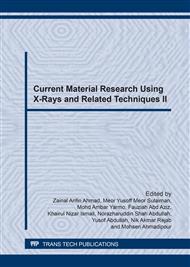p.198
p.203
p.209
p.216
p.222
p.228
p.234
p.239
p.244
The Properties of Epoxy/Graphene Conductive Materials Using High Speed Mechanical Stirrer and Bath Sonicator
Abstract:
In this work, two instruments were used to disperse graphene nanofillers into epoxy matrices, high speed mechanical stirrer and bath sonicator. Two stages experiment were conducted in order to achieve better dispersion of graphene fillers. Flexural test, fracture toughness test and density test were conducted on neat epoxy, 0.2 vol%, 0.4 vol%, 0.6 vol%, 0.8 vol% and 1 vol% graphene incorporated epoxy nanocomposites to observe the loading effect of graphene on the mechanical properties. Flexural results shown improvement in flexural strength graphene incorporated epoxy nanocomposites over neat epoxy. However, these enhancement were observed only up to 0.2 vol% filler loading after which the properties were seen to reduce. Reagglomeration of graphene nanofillers might be the factor that explained this phenomenon. Flexural modulus increased continuously as long as filler concentration increased. Fracture toughness results revealed the fracture toughness of nanocomposites fabricated using bath sonication has shown increasing trend with increasing filler concentration up to 1.0 vol% which not reach to optimum value yet. Nanocomposites fabricated using high speed mechanical stirrer has reached to optimum fracture toughness value at 0.6 vol% loadings. Further addition of graphene nanofillers promoted poor filler dispersion that resulting in decreased fracture toughness of nanocomposites. In addition, density of nanocomposites increased when greater amount of graphene nanofillers added regardless the processing techniques used. These results indicates that both processing techniques were suitable to disperse fillers at low loading only. However, bath sonication method was able to fabricate epoxy/graphene nanocomposites with more homogeneous filler dispersion compared to high speed mechanical mixing.
Info:
Periodical:
Pages:
222-227
Citation:
Online since:
March 2017
Authors:
Price:
Сopyright:
© 2017 Trans Tech Publications Ltd. All Rights Reserved
Share:
Citation:


